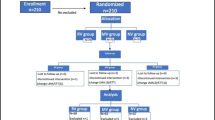Abstract
Purpose
The incidence of postoperative pharyngolaryngeal complications after laryngeal mask airway (LMA) insertion can be as high as 50 %. Over-inflation of the LMA cuff may be a causal factor. We conducted a single-centre parallel group randomised trial to determine whether maintaining LMA-ProSeal intra-cuff pressures below 60 cm H2O decreases postoperative pharyngolaryngeal complications.
Methods
We recruited 120 adult patients who were scheduled to undergo elective surgery under general anaesthesia. Appropriate sized LMA-ProSeal was inserted and the cuff was inflated with air (to no more than the maximum recommended volume) until there was no audible leak. Patients were randomised to either the control group (n = 60), where the intra-cuff pressure was noted and no further action was taken, or to the pressure-monitored group (n = 60), where intra-cuff pressure was maintained below 60 cm H2O. Pharyngolaryngeal complications consisting of sore throat, dysphonia and dysphagia were assessed at 1, 2, and 24 h postoperatively. Patients, anaesthesiologists and assessors were blinded to group allocation. The primary outcome was a composite endpoint of any pharyngolaryngeal complication at any of the three time points. Secondary outcomes were the incidence of individual outcomes at each time point.
Results
The incidence of pharyngolaryngeal complications at any time point was 42 % in the routine care group and 32 % in the pressure-monitored group (95 % CI for difference +28 to −7 %, p = 0.26). There was no difference between groups for any of the secondary outcomes.
Conclusion
Our study failed to demonstrate a statistically significant reduction in postoperative pharyngolaryngeal complications by limiting intra-cuff pressures in the LMA-Proseal.
Similar content being viewed by others
References
Seet E, Yousaf F, Gupta S, Subramanyam R, Wong DT, Chung F. Use of manometry for laryngeal mask airway reduces postoperative pharyngolaryngeal adverse events: a prospective, randomized trial. Anesthesiology. 2010;112:652–7.
Brimacombe J, Holyoake L, Keller C, Brimacombe N, Scully M, Barry J, Talbutt P, Sartain J, McMahon P. Pharyngolaryngeal, neck, and jaw discomfort after anesthesia with the face mask and laryngeal mask airway at high and low cuff volumes in males and females. Anesthesiology. 2000;93:26–31.
Cook TM, Lee G, Nolan JP. The ProSeal laryngeal mask airway: a review of the literature. Can J Anaesth. 2005;52:739–60.
McHardy FE, Chung F. Postoperative sore throat: cause, prevention and treatment. Anaesthesia. 1999;54:444–53.
Burgard G, Möllhoff T, Prien T. The effect of laryngeal mask cuff pressure on postoperative sore throat incidence. J Clin Anesth. 1996;8:198–201.
Nott MR, Noble PD, Parmar M. Reducing the incidence of sore throat with the laryngeal mask airway. Eur J Anaesthesiol. 1998;15:153–7.
Rieger A, Brunne B, Striebel HW. Intracuff pressures do not predict laryngopharyngeal discomfort after use of the laryngeal mask airway. Anesthesiology. 1997;87:63–7.
Figueredo E, Vivar-Diago M, Muñoz-Blanco F. Laryngo-pharyngeal complaints after use of the laryngeal mask airway. Can J Anaesth. 1999;46:220–5.
Brimacombe J, Keller C. The ProSeal laryngeal mask airway: a randomized, crossover study with the standard laryngeal mask airway in paralyzed, anesthetized patients. Anesthesiology. 2000;93:104–9.
LMA ProSeal. 2014. http://www.lmana.com/pwpcontrol.php?pwpID=4494). Accessed 1 Feb 2014.
Sharma B, Gupta R, Sehgal R, Koul A, Sood J. ProSeal laryngeal mask airway cuff pressure changes with and without use of nitrous oxide during laparoscopic surgery. J Anaesthesiol Clin Pharmacol. 2013;29:47–51.
Keller C, Puhringer F, Brimacombe JR. Influence of cuff volume on oropharyngeal leak pressure and fiberoptic position with the laryngeal mask airway. Br J Anaesth. 1998;81:186–7.
Evans NR, Gardner SV, James MF, King JA, Roux P, Bennett P, Nattrass R, Llewellyn R, Visu D. The Proseal laryngeal mask: results of a descriptive trial with experience of 300 cases. Br J Anaesth. 2002;88:534–9.
Kuppusamy A, Azhar N. Comparison of bougie-guided insertion of Proseal laryngeal mask airway with digital technique in adults. Indian J Anaesth. 2010;54:35–9.
Author information
Authors and Affiliations
Corresponding author
About this article
Cite this article
Vasanth Karthik, R., Ranganathan, P., Kulkarni, A.P. et al. Does cuff pressure monitoring reduce postoperative pharyngolaryngeal adverse events after LMA-ProSeal insertion? A parallel group randomised trial. J Anesth 28, 662–667 (2014). https://doi.org/10.1007/s00540-014-1811-0
Received:
Accepted:
Published:
Issue Date:
DOI: https://doi.org/10.1007/s00540-014-1811-0




